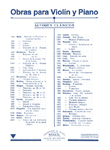Veu i Piano, vol. 1
Voz y Piano
CASALS, Pau; CASALS, PabloReg.: BC0007
24,70 €
P.V.P. (VAT included 4%)
Add to cart
- Review: CASALS ISTOMIN, Marta
- Ensemble: Duos: With piano; With voice.
- Genres: Classical / contemporary: Choir.
- Lyric author: MESTRES, Apel·les; , POPULAR; GAUTIER, Théophile; HEINE, Heinrich; SOLER, Joan Ramon; VERDAGUER, Jacint
- Language: Castellano/Català
- Product format: Partitura
- Difficulty level: Intermediate
- Period: 1st half S. XX
- Publishing house: Editorial Boileau
- Collection: Pau Casals
- No. of pages: 72
- Measure: 31,00 x 23,00 cm
- Lenght: 20'30"
- ISBN: 978-84-8020-937-3
- ISMN: 979-0-3503-0924-3
- Available in digital: No
- Available for rent: No
During the last years of the 19th century and the first half of the 20th, Catalan composers cultivated music for voice and accompaniment to an exceptional extent, as a result of the influence in Catalonia of the German musical practice. The interest posed by this kind of repertoire was obvious: it allowed for the composition of short pieces to be played in chamber performances, both during social events or in public concerts. It was not in the least uncommon to dedicate one’s creative efforts to the composition in this genre, be it for the combination of voice and piano or for any other accompanying instrument (such as the guitar, in vogue in our country). Within the genre, the composer worked on the matching of the voice –the referential variable– with the play on the music’s melody, harmony and rhythm, keeping close ties to national and world literature.
This inclination to the intertwining of disciplines, which had so seduced the first German romantics, was particularly preached by Wagner, both in his writings and in his artistic works. The texts that made up the lyrics of this type of composition used to be the work of prestigious artists, who normally wrote for no predetermined musician. It was later in the process, during the composition, that the matching elements linking the literary produce with the musical content were sought out. By means of the singability and the eloquence of the melodic line, the music tried to highlight and enhance the poetic elements of the text.
Pau Casals also fell under the spell of this challenge from the very beginning and, in fact, his first compositions use these resources. The collection of his works of this genre includes texts by authors from Casals’ circle such as Joan Ramon Soler, Apel·les Mestres, Joan Llongueres, Ventura Gassol (Minister of Culture of the Generalitat/Catalan government), as well as his exile companion and co-author of the monumental El pessebre, Joan Alavedra, or a poet who inspired many a musician, father Cinto Verdaguer. However, Casals also used in his compositions the works of acclaimed foreign authors such as German poet Heinrich Heine or the French Téophile Gautier, Paul Verlaine and François Coppée, as well as Matthieu Arnold, known for his in depth dealing with protestant spirituality.
This first volume includes the first works that Casals composed in the genre of voice accompanied by piano, based on texts written by authors who were close to him. They constitute a token of what Casals produced during the times when he was seeking a style of his own. The edition follows the order in which the works appear in the general catalogue, although in some cases it does not match a strictly chronological sequence.
Queixa Romanza I (1'10")
Romanza II (1'54")
En el mirall canviant de la mar blava (2'03")
A l’enterrament d’un nin / Lo lliri blanc (2'07")
No t’ha trobat (2'11")
Què curtes, vida meva, són les hores (2'51")
Adiós...! Lo blat és segat (2'43")
Romança III “Son image” (1'55")








